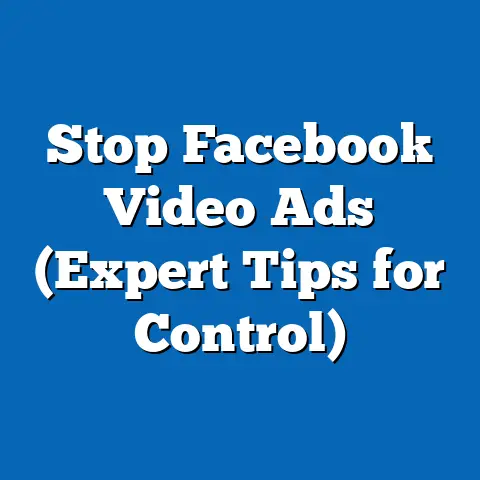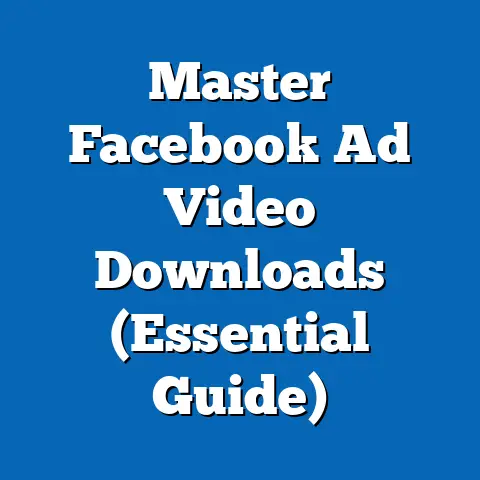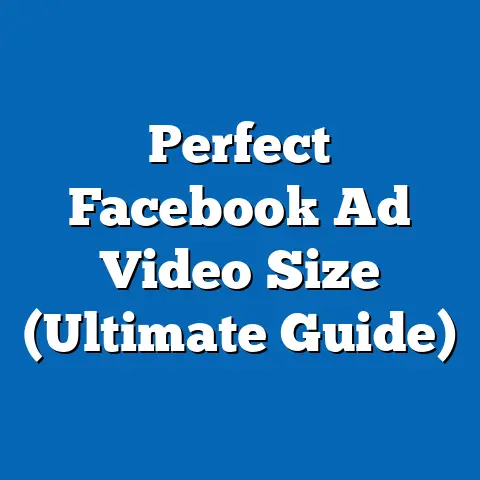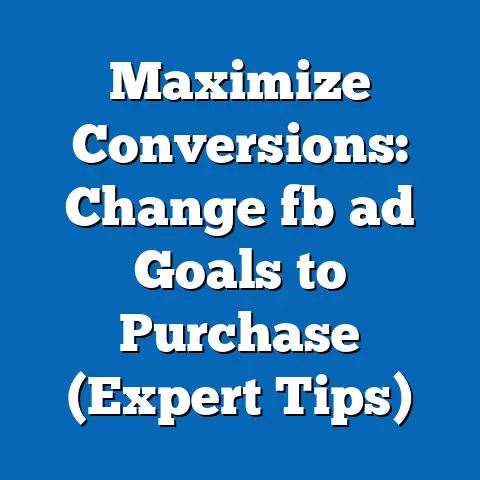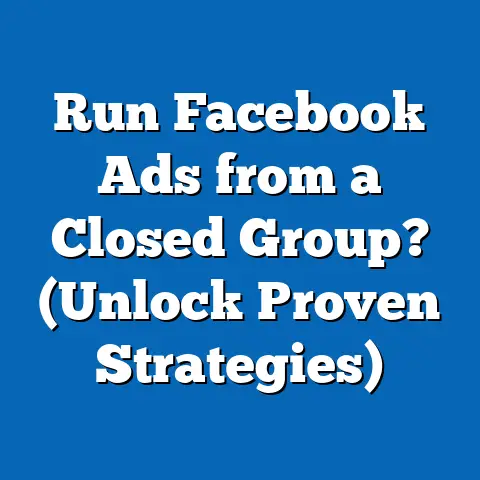Boost Facebook Business Page (Proven Conversion Tactics)
I remember when I first started dabbling in Facebook advertising. I was running a small online store selling handmade jewelry. I had beautiful products, but my website traffic was dismal, and sales were even worse. I knew I needed to do something, and everyone kept telling me Facebook Ads were the way to go. Honestly, I was overwhelmed! I threw some money at a basic ad, crossed my fingers, and waited. The result? A whole lot of nothing. It was frustrating and discouraging.
But I didn’t give up. I started researching, experimenting, and learning from my mistakes. I dug into audience targeting, A/B tested different ad creatives, and obsessed over metrics. Slowly but surely, things started to improve. I went from throwing money into the void to running targeted campaigns that actually generated leads and sales. And that’s where I understood the game.
The truth is, Facebook advertising, when done right, can be a game-changer for businesses of all sizes. Take, for example, a local bakery I worked with. They were struggling to get new customers through their door. By implementing a targeted Facebook ad campaign focusing on nearby residents and offering a special discount, they saw a 40% increase in foot traffic within a month! That’s the power of a well-executed Facebook strategy.
Today, Facebook remains a dominant force in the digital marketing landscape. With billions of active users, it offers unparalleled reach and targeting capabilities for businesses looking to connect with their ideal customers. But simply having a Facebook Business Page isn’t enough. You need to implement proven conversion tactics to turn those likes and followers into paying customers.
In this guide, I’ll walk you through the strategies I’ve learned and perfected over the years, the same strategies that helped me turn my initial Facebook advertising failures into successes. We’ll cover everything from understanding your audience to crafting compelling ad content and optimizing your campaigns for maximum ROI. Get ready to transform your Facebook Business Page into a powerful conversion machine!
Section 1: Understanding the Facebook Business Page
A Facebook Business Page is more than just a profile for your company; it’s a digital storefront, a customer service hub, and a powerful marketing tool all rolled into one. It’s the foundation upon which your Facebook advertising strategy is built.
Think of it this way: your personal Facebook profile is for connecting with friends and family, sharing personal updates, and engaging in casual conversations. A Facebook Business Page, on the other hand, is designed specifically for businesses to connect with customers, build brand awareness, and drive sales.
Why is a Facebook Business Page so important?
- Increased Visibility: It allows you to reach a massive audience of potential customers.
- Enhanced Credibility: A professional-looking page with valuable content builds trust and authority.
- Direct Customer Communication: You can interact with customers directly through posts, comments, and messages.
- Targeted Advertising: Facebook Ads Manager allows you to create highly targeted ad campaigns to reach your ideal audience.
- Valuable Insights: Facebook Insights provides data on your audience, engagement, and ad performance, allowing you to optimize your strategy.
Key Features of a Facebook Business Page:
- About Section: This is your chance to tell your story, explain what you do, and provide essential contact information. Make sure it’s clear, concise, and compelling.
- Posts: Share valuable content, updates, promotions, and engaging visuals to keep your audience interested.
- Call-to-Action (CTA) Buttons: These buttons encourage specific actions, such as “Shop Now,” “Learn More,” or “Contact Us.” Choose the CTA that aligns with your business goals.
- Reviews: Positive reviews build trust and social proof. Encourage satisfied customers to leave reviews on your page.
- Insights: Track your page’s performance, understand your audience demographics, and see which content resonates most.
- Ads Manager Integration: Seamlessly create and manage Facebook ad campaigns directly from your page.
Taking Action:
- Optimize Your Page: Ensure your About section is complete and compelling.
- Choose a Relevant CTA: Select the button that aligns with your primary business goal (e.g., driving website traffic, generating leads, or increasing sales).
- Post Regularly: Share valuable content that your audience will find interesting and engaging.
Takeaway: Your Facebook Business Page is the cornerstone of your Facebook marketing efforts. By optimizing your page and utilizing its features effectively, you can create a powerful platform for customer engagement and conversion.
Section 2: The Importance of Audience Targeting
Imagine trying to sell snow shovels in the middle of summer in Florida. Sounds ridiculous, right? That’s what it’s like running Facebook ads without proper audience targeting. You’re essentially throwing money at people who have no interest in what you’re offering.
Audience targeting is the process of defining the specific group of people you want to reach with your Facebook ads. It’s about identifying the demographics, interests, behaviors, and other characteristics that make your ideal customer.
Why is audience targeting so crucial?
- Increased Relevance: Showing your ads to the right people increases the likelihood that they’ll be interested in your product or service.
- Higher Engagement: Relevant ads lead to higher click-through rates, more likes, comments, and shares.
- Improved Conversion Rates: When you target the right audience, you’re more likely to generate leads and sales.
- Reduced Ad Spend: By focusing your budget on the most likely prospects, you can avoid wasting money on people who are unlikely to convert.
Facebook’s Targeting Options:
- Demographics: Target by age, gender, location, education, job title, relationship status, and more.
- Interests: Target based on people’s interests, hobbies, and the pages they like on Facebook.
- Behaviors: Target based on people’s online behavior, such as purchase history, device usage, and travel habits.
- Custom Audiences: Upload your own customer data (e.g., email lists, phone numbers) to create targeted audiences.
- Lookalike Audiences: Find new people who are similar to your existing customers.
Creating Buyer Personas:
A buyer persona is a semi-fictional representation of your ideal customer. It’s based on research and data about your existing customers, as well as insights into your target market.
When I create a buyer persona, I think about the following:
- Demographics: Age, gender, location, income, education, occupation
- Psychographics: Values, interests, lifestyle, personality
- Goals: What are they trying to achieve?
- Challenges: What are their pain points?
- Motivations: What drives their purchasing decisions?
- Where do they spend their time online? Which Facebook pages do they follow?
Example:
Let’s say you’re selling organic baby food. Your buyer persona might be “Sarah,” a 32-year-old mother living in a suburban area with a household income of $80,000. Sarah is health-conscious and values organic products for her baby. She’s concerned about the ingredients in conventional baby food and wants to provide her child with the best possible nutrition. She spends time on Facebook in parenting groups and follows pages related to organic living and healthy recipes.
Using Buyer Personas for Targeting:
Once you’ve created your buyer personas, you can use them to inform your Facebook ad targeting. For example, you could target Facebook users who are:
- Mothers with young children
- Interested in organic food, parenting, and healthy living
- Living in suburban areas
Takeaway: Audience targeting is the foundation of a successful Facebook advertising campaign. By defining your ideal customer and leveraging Facebook’s targeting options, you can ensure that your ads are seen by the right people, leading to higher engagement and conversion rates.
Section 3: Crafting Compelling Ad Content
You’ve got your targeting dialed in, but now what? You need to create ads that grab attention, resonate with your audience, and persuade them to take action. This is where compelling ad content comes in.
Think of your ad as a mini-sales pitch. You have a limited amount of time and space to capture someone’s attention and convince them that your product or service is worth their time and money.
Components of Effective Ad Copy:
- Headline: This is the first thing people see, so it needs to be attention-grabbing and relevant. Use strong verbs, numbers, and keywords to make it stand out.
- Body Text: This is where you explain the benefits of your product or service and address your audience’s pain points. Keep it concise, clear, and focused on the value you’re offering.
- Call-to-Action (CTA): Tell people exactly what you want them to do next. Use action-oriented language like “Shop Now,” “Learn More,” or “Sign Up.”
I’ve learned that these strategies are key for engaging ad content:
- Know Your Audience: Tailor your message to your target audience’s specific needs and interests. Use language they understand and address their pain points directly.
- Highlight Benefits, Not Just Features: Focus on the value you’re providing, not just the technical specifications of your product or service. How will it improve their lives?
- Use Strong Visuals: Images and videos are crucial for capturing attention and conveying your message quickly. Choose high-quality visuals that are relevant to your ad copy.
- Keep it Concise: People have short attention spans, so get to the point quickly. Use short sentences and paragraphs, and avoid jargon.
- Create a Sense of Urgency: Encourage people to take action now by using phrases like “Limited Time Offer” or “While Supplies Last.”
- A/B Test Everything: Experiment with different headlines, body text, visuals, and CTAs to see what works best for your audience.
The Power of Visuals:
Visuals are a critical component of effective Facebook ads. They’re the first thing people see, and they can make or break your ad’s performance.
Tips for Choosing Compelling Visuals:
- Use High-Quality Images and Videos: Avoid blurry or pixelated visuals.
- Choose Relevant Visuals: Make sure your visuals are directly related to your product or service and your ad copy.
- Showcase Your Product in Action: Demonstrate how your product works and the benefits it provides.
- Use Eye-Catching Colors and Designs: Experiment with different colors and designs to see what grabs attention.
- Consider Using Video: Video ads can be more engaging and effective than static images.
Example:
Let’s say you’re advertising a new line of yoga mats.
- Headline: “Find Your Zen with Our New Organic Yoga Mats”
- Body Text: “Made from sustainably sourced materials, our yoga mats provide the perfect balance of comfort and support. Shop now and experience the difference!”
- Visual: A high-quality image of someone doing yoga on your mat in a serene setting.
- CTA: “Shop Now”
Takeaway: Compelling ad content is essential for capturing attention, engaging your audience, and driving conversions. By crafting clear, concise, and visually appealing ads that highlight the benefits of your product or service, you can increase your chances of success on Facebook.
Section 4: Utilizing Facebook Pixel for Remarketing
Have you ever visited a website, looked at a specific product, and then suddenly started seeing ads for that product everywhere you go on Facebook? That’s the power of Facebook Pixel and remarketing.
Facebook Pixel is a small piece of code that you place on your website. It tracks user interactions, such as page views, add-to-carts, and purchases. This data allows you to create customized remarketing campaigns that target people who have already shown interest in your products or services.
Why is Facebook Pixel so valuable?
- Track Website Conversions: See which of your Facebook ads are driving the most sales and leads.
- Optimize Ad Spend: Focus your budget on the ads that are generating the best results.
- Create Custom Audiences: Target people who have taken specific actions on your website.
- Remarket to Website Visitors: Show ads to people who have visited your website but haven’t yet converted.
- Build Lookalike Audiences: Find new people who are similar to your existing customers.
How to Use Facebook Pixel for Remarketing:
- Install the Pixel: Place the Facebook Pixel code on every page of your website.
- Track Events: Set up event tracking to track specific actions, such as page views, add-to-carts, and purchases.
- Create Custom Audiences: Create audiences based on the events you’re tracking. For example, you could create an audience of people who have visited your product page but haven’t added the product to their cart.
- Create Remarketing Ads: Design ads that are specifically tailored to the people in your custom audiences. For example, you could show ads featuring the products they viewed on your website, or offer a special discount to encourage them to complete their purchase.
Examples of Successful Remarketing Tactics:
- Abandoned Cart Recovery: Show ads to people who have added products to their cart but haven’t completed their purchase. Offer a discount or free shipping to incentivize them to come back and finish their order.
- Product Upselling/Cross-selling: Show ads for related products to people who have already purchased something from you.
- Lead Nurturing: Show ads that provide valuable information and build trust with people who have downloaded a lead magnet or signed up for your email list.
A Real-World Example:
I worked with an e-commerce store that was struggling with abandoned carts. We implemented a remarketing campaign that targeted people who had added items to their cart but didn’t complete the purchase. The ads featured the specific items they had left in their cart, along with a 10% discount code. This campaign resulted in a 20% increase in recovered abandoned carts and a significant boost in revenue.
Takeaway: Facebook Pixel is a powerful tool for tracking user behavior, creating custom audiences, and running targeted remarketing campaigns. By leveraging pixel data, you can re-engage website visitors, recover abandoned carts, and drive more conversions.
Section 5: Analyzing and Optimizing Ad Performance
Running Facebook ads is not a “set it and forget it” activity. It requires continuous monitoring, analysis, and optimization to ensure you’re getting the best possible results.
Facebook Insights and Ads Manager provide a wealth of data that you can use to understand how your ads are performing and identify areas for improvement.
Key Metrics to Track:
- Reach: The number of unique people who saw your ad.
- Impressions: The number of times your ad was displayed.
- Click-Through Rate (CTR): The percentage of people who saw your ad and clicked on it. A higher CTR indicates that your ad is relevant and engaging.
- Cost Per Click (CPC): The average amount you pay each time someone clicks on your ad.
- Conversion Rate: The percentage of people who clicked on your ad and completed a desired action, such as making a purchase or filling out a form.
- Return on Ad Spend (ROAS): The amount of revenue you generate for every dollar you spend on advertising.
Understanding the Metrics:
- Low Reach: Your targeting may be too narrow, or your budget may be too low.
- Low CTR: Your ad copy or visuals may not be compelling enough.
- High CPC: Your ad may not be relevant to your audience, or your competition may be driving up the price.
- Low Conversion Rate: Your landing page may not be optimized for conversions, or your product or service may not be appealing to your target audience.
- Low ROAS: You may be spending too much on advertising and not generating enough revenue.
A/B Testing:
A/B testing is the process of comparing two versions of an ad to see which one performs better. You can A/B test different headlines, body text, visuals, and CTAs.
Here’s how I approach A/B testing:
- Choose One Variable to Test: Focus on testing one element at a time so you can accurately measure its impact.
- Create Two Versions of Your Ad: Change only the variable you’re testing.
- Run Your Ads Simultaneously: Ensure both ads run at the same time to avoid external factors influencing the results.
- Track Your Results: Monitor the key metrics for each ad to see which one performs better.
- Implement the Winning Version: Pause the underperforming ad and continue running the winning ad.
- Repeat the Process: Continuously A/B test different elements to optimize your ad performance over time.
Tips for Continuous Optimization:
- Monitor Your Ads Daily: Keep a close eye on your ad performance and make adjustments as needed.
- Experiment with Different Targeting Options: Try different demographics, interests, and behaviors to see which ones drive the best results.
- Refine Your Ad Copy and Visuals: Continuously test different headlines, body text, and visuals to improve your CTR and conversion rates.
- Optimize Your Landing Page: Make sure your landing page is relevant to your ad and optimized for conversions.
- Stay Up-to-Date on Facebook’s Best Practices: Facebook is constantly evolving, so stay informed about the latest changes and best practices.
Takeaway: Analyzing and optimizing your ad performance is crucial for maximizing your ROI on Facebook. By tracking key metrics, A/B testing different elements, and continuously refining your strategy, you can improve your ad performance over time and drive more conversions.
Section 6: Building Community and Engagement
While driving conversions is important, it’s equally important to build a community around your Facebook Business Page. A strong community can lead to increased brand loyalty, positive word-of-mouth marketing, and long-term customer relationships.
Think of your Facebook Business Page as a place where people can connect with your brand, learn more about your products or services, and engage in meaningful conversations.
Strategies for Engaging with Followers:
- Post Regularly: Share valuable content that your audience will find interesting and engaging.
- Ask Questions: Encourage your followers to share their thoughts and opinions.
- Run Contests and Giveaways: Generate excitement and attract new followers.
- Respond to Comments and Messages: Show your followers that you care about their feedback and questions.
- Go Live: Host live Q&A sessions, product demos, or behind-the-scenes tours.
- Create a Facebook Group: Foster a sense of community by creating a group where your followers can connect with each other and share their experiences.
Examples of Successful Brands:
- Nike: Nike uses its Facebook page to share inspiring stories, promote its products, and engage with its community of athletes.
- Starbucks: Starbucks uses its Facebook page to share promotions, announce new products, and engage with its fans through contests and giveaways.
- Sephora: Sephora uses its Facebook page to share beauty tips, tutorials, and product reviews, as well as to engage with its community of beauty enthusiasts.
The Importance of Authenticity:
In today’s digital age, authenticity is more important than ever. People can spot a fake or inauthentic brand from a mile away.
Here’s how I recommend being authentic:
- Be Transparent: Share your company’s values, mission, and story.
- Be Human: Show the faces behind your brand and let your personality shine through.
- Be Responsive: Respond to comments and messages promptly and professionally.
- Be Honest: Admit your mistakes and take responsibility for your actions.
- Be Consistent: Maintain a consistent brand voice and messaging across all your channels.
Takeaway: Building a community around your Facebook Business Page is essential for fostering brand loyalty, driving engagement, and generating long-term customer relationships. By engaging with your followers, being authentic, and providing valuable content, you can create a thriving community that supports your business.
Conclusion
Boosting your Facebook Business Page requires a strategic approach that combines targeted advertising, compelling content, and community building. By understanding the importance of audience targeting, crafting engaging ad copy, utilizing Facebook Pixel for remarketing, and continuously analyzing and optimizing your ad performance, you can effectively boost your visibility, engagement, and ultimately, conversions on the platform.
Remember, Facebook advertising is an ongoing process that requires patience, persistence, and a willingness to experiment. Don’t be afraid to try new things, track your results, and adjust your strategy as needed.
I encourage you to take action and begin optimizing your Facebook Business Page today. By implementing the strategies discussed in this guide, you can unlock the full potential of Facebook advertising and drive significant growth for your business. Good luck!

